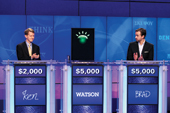Winning the Race With Ever-Smarter Machines
Rapid advances in information technology are yielding applications that can do anything from answering game show questions to driving cars. But to gain true leverage from these ever-improving technologies, companies need new processes and business models.
Topics

In 2011, an IBM supercomputer called Watson beat human champions in the Jeopardy! game show.
Image courtesy of IBM.
In the past few years, progress in information technology — in computer hardware, software and networks — has been so rapid and so surprising that many present-day organizations, institutions, policies and mind-sets are not keeping up. We used to be pretty confident that we knew the relative strengths and weaknesses of computers vis-à-vis humans. But computers have started making inroads in some unexpected areas — and this has significant implications for managers and organizations.
A clear illustration of the dramatic increase in computing power comes from comparing a book published in 2004 with an announcement made in 2010. The book is The New Division of Labor by economists Frank Levy and Richard Murnane, and it’s a thoroughly researched description of the comparative capabilities of computers and human workers.
In its second chapter, titled “Why People Still Matter,” the authors present a spectrum of information-processing tasks. At one end are straightforward applications of existing rules. These tasks, such as performing arithmetic, can be easily automated, since computers are good at following rules.
At the other end of the complexity spectrum are pattern recognition tasks where the rules can’t be inferred. The New Division of Labor gives driving in traffic as an example of this type of task, and asserts that it is not automatable:
The … truck driver is processing a constant stream of [visual, aural and tactile] information from his environment. … [T]o program this behavior we could begin with a video camera and other sensors to capture the sensory input. But executing a left turn against oncoming traffic involves so many factors that it is hard to imagine discovering the set of rules that can replicate a driver’s behavior. …
Articulating [human] knowledge and embedding it in software for all but highly structured situations are at present enormously difficult tasks. … Computers cannot easily substitute for humans in [jobs like truck driving].1
The results of the first DARPA Grand Challenge, held in 2004, supported Levy and Murnane’s conclusion. The challenge was to build a driverless vehicle that could navigate a 142-mile route through the Mojave Desert. The “winning” team made it less than eight miles before failing.
References
1. F. Levy and R. Murnane, “The New Division of Labor: How Computers Are Creating the Next Job Market” (Princeton, New Jersey: Princeton University Press, 2004).
2. J. Hooper, “From DARPA Grand Challenge 2004: DARPA’s Debacle in the Desert,” June 4, 2004, www.popsci.com.
3. S. Thrun, “What We’re Driving At,” October 9, 2010, http://googleblog.blogspot.com.
4. Levy and Murnane, “The New Division of Labor.”
5. To be precise, Jeopardy! contestants are shown answers and must ask questions that would yield these answers.
6. J. Markoff, “Computer Wins on ‘Jeopardy!’: Trivial, It’s Not,” New York Times, Feb. 17, 2011.
7. G.E. Moore, “Cramming More Components Onto Integrated Circuits,” Electronics, April 19, 1965, 114-117.
8. M. Kanellos, “Moore’s Law to Roll on for Another Decade,” February 10, 2003, http://news.cnet.com.
9. K. Greene, “A New and Improved Moore’s Law,” Technology Review, September 12, 2011.
10. President’s Council of Advisors on Science and Technology, “Designing a Digital Future: Federally Funded Research and Development in Networking and Information Technology,” December 2010, www.whitehouse.gov.
11. R. Kurzweil, “The Age of Spiritual Machines: When Computers Exceed Human Intelligence” (New York: Penguin Books, 2000).
12. S. Basu and J. Fernald, “Information and Communications Technology as a General-Purpose Technology: Evidence From U.S Industry Data,” Working Paper Series 2006-29, Federal Reserve Bank of San Francisco, San Francisco, California, 2006.
13. Railroad construction crews in that period blasted tunnels though mountainsides by drilling holes into the rock, packing the holes with explosives and detonating them to lengthen the tunnel.
14. G. Kasparov, “The Chess Master and the Computer,” New York Review of Books, February 11, 2010.
15. Ibid.
16. F. Khatib, F. DiMaio, Foldit Contenders Group, Foldit Void Crushers Group, S. Cooper, M. Kazmierczyk, M. Gilski, S. Krzywda, H. Zabranska, I. Pichova, J. Thompson, Z. Popovi´c, M. Jaskolski and D. Baker, “Crystal Structure of a Monomeric Retroviral Protease Solved by Protein Folding Game Players,” Nature Structural & Molecular Biology 18 (2011): 1175-1177.
17. M.V. Copeland, “The Mighty Micro-Multinational,” Business 2.0, July 1, 2006.
18. M.S. Hopkins and L. Brokaw, “Matchmaking With Math: How Analytics Beats Intuition to Win Customers,” MIT Sloan Management Review 52, no. 2 (winter 2011): 35-41.
19. A. McAfee and E. Brynjolfsson, “Investing in the IT That Makes a Competitive Difference,” Harvard Business Review 86 (July-August 2008): 98-107.
i. S. Lohr, “For Today’s Graduate, Just One Word: Statistics,” New York Times, Aug. 5, 2009.

Comments (6)
Using Artificial Intelligence to Set Information Free by Reid Hoffman | Inteligência Competitiva por Alfredo Passos
Tech–No Jobs? | My Blog
Ros Earl
Where We’re at in the Race Against the Machines | Enjoying The Moment
Where We’re at in the Race Against the Machines | My Web Marketing Planner Blog
Doug Laney